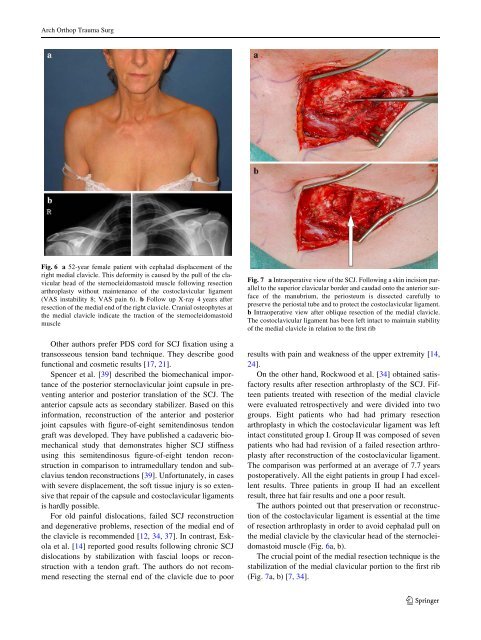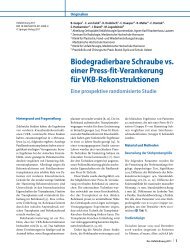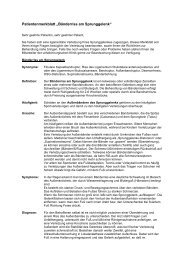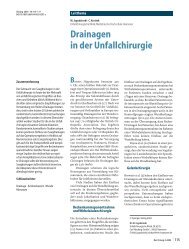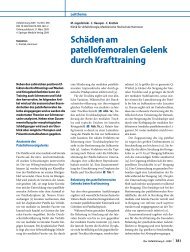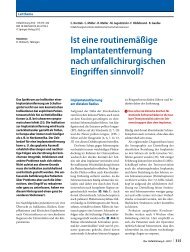Long-term outcome after joint reconstruction or ... - ResearchGate
Long-term outcome after joint reconstruction or ... - ResearchGate
Long-term outcome after joint reconstruction or ... - ResearchGate
You also want an ePaper? Increase the reach of your titles
YUMPU automatically turns print PDFs into web optimized ePapers that Google loves.
Arch Orthop Trauma Surg<br />
Fig. 6 a 52-year female patient with cephalad displacement of the<br />
right medial clavicle. This def<strong>or</strong>mity is caused by the pull of the clavicular<br />
head of the sternocleidomastoid muscle following resection<br />
arthroplasty without maintenance of the costoclavicular ligament<br />
(VAS instability 8; VAS pain 6). b Follow up X-ray 4 years <strong>after</strong><br />
resection of the medial end of the right clavicle. Cranial osteophytes at<br />
the medial clavicle indicate the traction of the sternocleidomastoid<br />
muscle<br />
Other auth<strong>or</strong>s prefer PDS c<strong>or</strong>d f<strong>or</strong> SCJ Wxation using a<br />
transosseous tension band technique. They describe good<br />
functional and cosmetic results [17, 21].<br />
Spencer et al. [39] described the biomechanical imp<strong>or</strong>tance<br />
of the posteri<strong>or</strong> sternoclavicular <strong>joint</strong> capsule in preventing<br />
anteri<strong>or</strong> and posteri<strong>or</strong> translation of the SCJ. The<br />
anteri<strong>or</strong> capsule acts as secondary stabilizer. Based on this<br />
inf<strong>or</strong>mation, <strong>reconstruction</strong> of the anteri<strong>or</strong> and posteri<strong>or</strong><br />
<strong>joint</strong> capsules with Wgure-of-eight semitendinosus tendon<br />
graft was developed. They have published a cadaveric biomechanical<br />
study that demonstrates higher SCJ stiVness<br />
using this semitendinosus Wgure-of-eight tendon <strong>reconstruction</strong><br />
in comparison to intramedullary tendon and subclavius<br />
tendon <strong>reconstruction</strong>s [39]. Unf<strong>or</strong>tunately, in cases<br />
with severe displacement, the soft tissue injury is so extensive<br />
that repair of the capsule and costoclavicular ligaments<br />
is hardly possible.<br />
F<strong>or</strong> old painful dislocations, failed SCJ <strong>reconstruction</strong><br />
and degenerative problems, resection of the medial end of<br />
the clavicle is recommended [12, 34, 37]. In contrast, Eskola<br />
et al. [14] rep<strong>or</strong>ted good results following chronic SCJ<br />
dislocations by stabilization with fascial loops <strong>or</strong> <strong>reconstruction</strong><br />
with a tendon graft. The auth<strong>or</strong>s do not recommend<br />
resecting the sternal end of the clavicle due to po<strong>or</strong><br />
Fig. 7 a Intraoperative view of the SCJ. Following a skin incision parallel<br />
to the superi<strong>or</strong> clavicular b<strong>or</strong>der and caudad onto the anteri<strong>or</strong> surface<br />
of the manubrium, the periosteum is dissected carefully to<br />
preserve the periostal tube and to protect the costoclavicular ligament.<br />
b Intraoperative view <strong>after</strong> oblique resection of the medial clavicle.<br />
The costoclavicular ligament has been left intact to maintain stability<br />
of the medial clavicle in relation to the Wrst rib<br />
results with pain and weakness of the upper extremity [14,<br />
24].<br />
On the other hand, Rockwood et al. [34] obtained satisfact<strong>or</strong>y<br />
results <strong>after</strong> resection arthroplasty of the SCJ. Fifteen<br />
patients treated with resection of the medial clavicle<br />
were evaluated retrospectively and were divided into two<br />
groups. Eight patients who had had primary resection<br />
arthroplasty in which the costoclavicular ligament was left<br />
intact constituted group I. Group II was composed of seven<br />
patients who had had revision of a failed resection arthroplasty<br />
<strong>after</strong> <strong>reconstruction</strong> of the costoclavicular ligament.<br />
The comparison was perf<strong>or</strong>med at an average of 7.7 years<br />
postoperatively. All the eight patients in group I had excellent<br />
results. Three patients in group II had an excellent<br />
result, three hat fair results and one a po<strong>or</strong> result.<br />
The auth<strong>or</strong>s pointed out that preservation <strong>or</strong> <strong>reconstruction</strong><br />
of the costoclavicular ligament is essential at the time<br />
of resection arthroplasty in <strong>or</strong>der to avoid cephalad pull on<br />
the medial clavicle by the clavicular head of the sternocleidomastoid<br />
muscle (Fig. 6a, b).<br />
The crucial point of the medial resection technique is the<br />
stabilization of the medial clavicular p<strong>or</strong>tion to the Wrst rib<br />
(Fig. 7a, b) [7, 34].<br />
123


